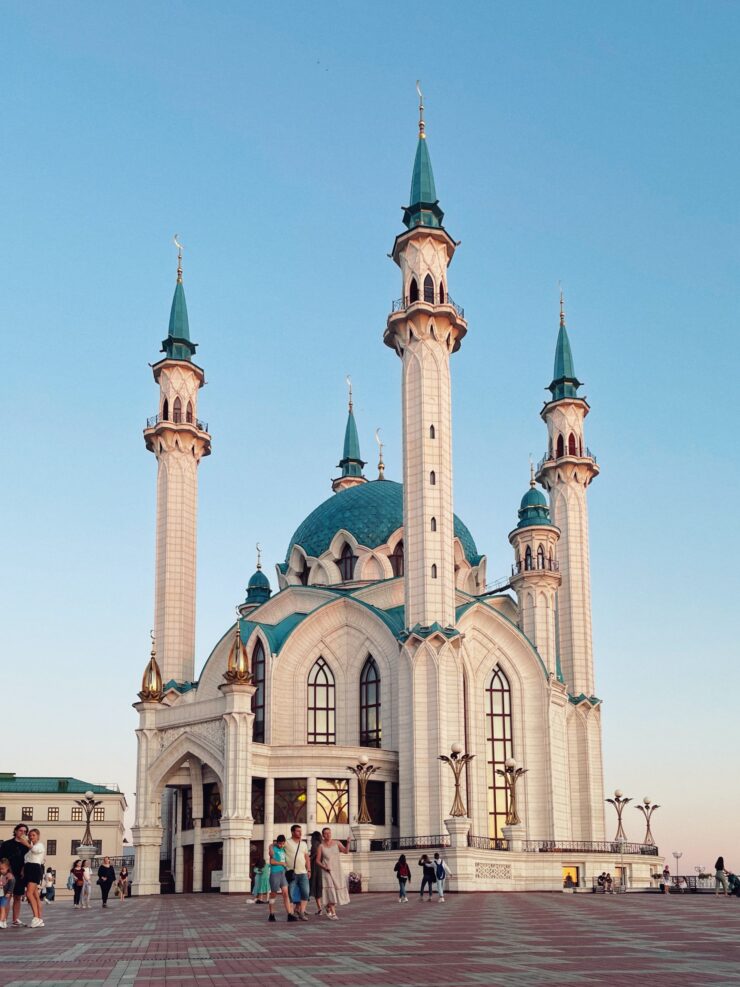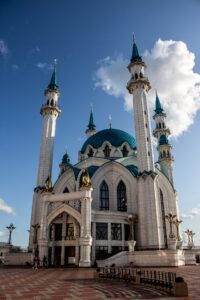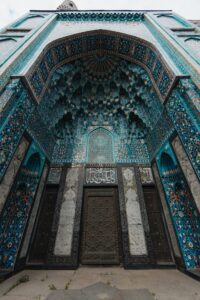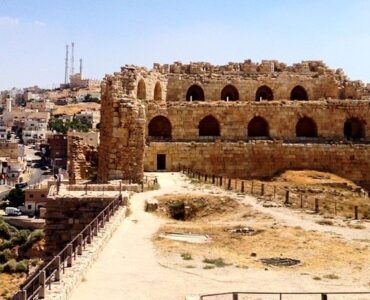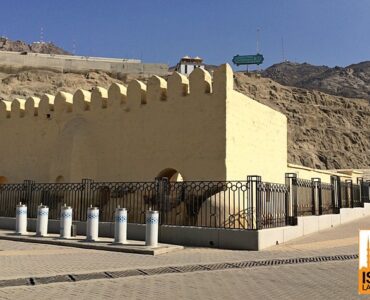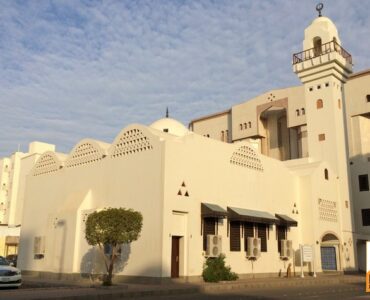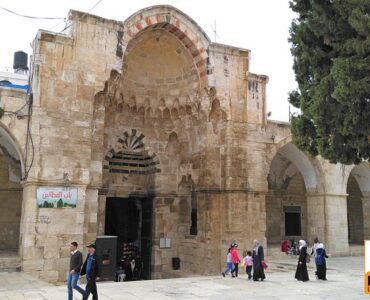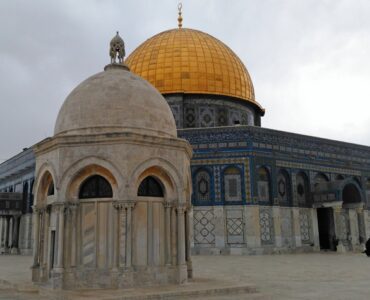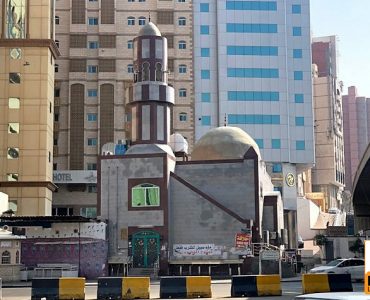Named after Imam Seyid Kul Sharif, a religious scholar who died while defending the city of Kazan, the Kul Sharif mosque stands as a living testament to the resilience and cultural fusion that binds nations.
Uniting two religions and bridging the East and the West, the architectural masterpiece is a beacon of peace and beauty that illuminates the vibrant mosaic of Kazan Kremlin.
The Kul Sharif mosque features eight minarets and is divided into two floors, one for the Muslim worshippers and the other for the tourists to explore and learn about the history and culture of Kazan and Tatarstan.
The Kremlin mosque walls are engraved with the verses of the Holy Quran and richly decorated with ornamental braids. Read on to learn more about the Kul Sharif mosque.
Kul Sharif Mosque History
Four centuries ago, in the capital of Kazan Khanate stood the Kul Sharif mosque. Named after its Imam, Seyid Kul Sharif, the beautiful five-floor mosque featured a library and eight minarets pointing toward different parts of the world.
Tragically during the Siege of Kazan in 1552, Ivan and Russian troops conquered the whole city and burned down all Muslim buildings, including the Kul Sharif mosque. Orthodox churches replaced the Islamic sites.
Four centuries later, in 1996, the President of Tatarstan ordered the reconstruction of the Kul Sharif mosque. Bearing the name of the last Imam – Seyid Kul Sharif –it took nine years to complete the great Kul Sharif mosque.
According to historians, in 1997, the mosque’s foundation was laid. Later in 1998, a monolithic frame cast and basement were made, and it took two years to develop and install the metal tops of the minaret and domes on the Kul Sharif mosque.
The establishment of the mosque was funded by organisations of Tatarstan, donations from Muslim countries, and the residents.
The inauguration of the Kul Sharif mosque took place on 24 July 2005, coinciding with the 1000-year anniversary of Kazan as the capital of Tatarstan.
Why Was the Kul Sharif Mosque Built?
The Kul Sharif mosque was built to recreate the ancient Masjid and commemorate the sacrifice and bravery of Imam Kul Sharif, who was killed on the roof of the mosque before the invaders destroyed it.
When Was Kul Sharif Mosque Built?
Originally constructed in the early 16th Century, the Kul Sharif mosque was demolished by Ivan and his forces during a historic battle in 1552.
The Kul Sharif mosque was rebuilt and re-opened to the public in 2005 under the governance of the President of Tatarstan. However, it took nine years to complete the construction of the Qul Sharif Mosque.
Location of Kul Sharif Mosque
The Kul Sharif mosque is located in the city of Kazan, Tatarstan, in Russia. Click here to view the location of Kul Sharif mosque on Google Maps.
Interior
The Kul Sharif mosque comprises five floors, a basement, a technical floor, and three ground floors with an ablution room, a distribution lobby, and an Islamic museum. There are two separate prayer halls for male and female worshipers.
The hand-painted and light in the colour interior of the Kul Sharif mosque creates a solemn atmosphere. Inside the Kul Sharif mosque, you will also find Roman mosaics, stucco molding, ceramic panels, wood and stone carving, and stained-glass windows.
The main prayer hall has Persian rugs and a huge crystal chandelier weighing 2 tons. The room has 300 lamps, a beautiful wall painted with the names of Allah SWT, and verses from the Holy Quran.
Floor Plan
The Kul Sharif mosque has five floors. The ground floor is a Museum of Islam, the first floor has a prayer hall for men and the Imam’s office, and the second floor includes a place for women worshippers and several tourist zones.
The Kul Sharif mosque also has a fire department and a unique publishers’ library.
According to the floor plan, the Kul Sharif mosque is built at the intersection of two squares at an angle of 45 degrees, forming the sign of blessings of Allah SWT.
The windows on the dome are carved in tulip shape to represent the symbol of rebirth. The floor plan covers 19,000 square metres of land.
Architecture
The Kul Sharif mosque is situated in the western region of the Kazan Kremlin. The architectural features of the five-floor Kul Sharif mosque include eight 88 metres tall minarets (2 near the entrance gate, 4 main, and 2 small), a 36 metres high dome, high stained glass window openings, and arch-shaped walls with inscriptions from the Holy Quran.
While the white marble façade emanates a timeless splendor, painted in turquoise, the main minaret and dome add a touch of ethereal charm. The Kul Sharif mosque also includes a Jumma Mosque, a memorial stone, a fire station, a library, and an administrative building.
The indoor area can accommodate 1500 worshipers, and the outdoor courtyard is spacious enough for 10,000 Muslims to pray peacefully
Kul Sharif Mosque Facts
The Kul Sharif mosque is one of the largest and most beautiful Masjids in Russia and outside Europe. Listed below are five unique and interesting facts about Kul Sharif mosque:
The Kul Sharif Mosque was demolished in 1552
An unknown fact about the Kul Sharif mosque is that it wasn’t built in 2005. In fact, the great mosque of Kazan Khanate was constructed in the 16th Century. Sadly, in 1552 during a war with the Russians, the Kul Sharif mosque was completely destroyed.
Guided by the hands of skilled artisans and visionaries of the city, the reconstruction of the Kul Sharif mosque began in 1996 and was restored to its full splendor in 2005.
The Kul Sharif Mosque is named after a famous imam
The Kul Sharif mosque is named after ” Seyid Kul Sharif,” an Islamic scholar who died during the Siege of Kazan while defending the city against the Russian forces in 1552. The Kul Sharif mosque is a tribute to the Imam from the President of Tatars for his services, bravery, and devotion.
Muslims from all around the world participated in the construction of the Kul Sharif Mosque
The unique and majestic architecture of the Kul Sharif mosque was constructed with parts from all over the world. Made in the Czech Republic, the chandeliers were sketched by renowned artists in Tatarstan.
Covering the floor of the Kul Sharif mosque, the lush carpets were manufactured in Persia. The donation fund for the grand mosque came from countries worldwide, including Saudi Arabia. The names of the donors are inscribed in the main hall, where the large Quran is present.
The mosque Kazan can accommodate over 10,000 people in the outdoor area and 1500 worshippers inside.
Kul Sharif Mosque symbolises peaceful coexistence
Standing adjacent to the Annunciation Cathedral in the Kazan Kremlin complex, the Kul Sharif mosque symbolises the peaceful coexistence of two very different religions. Inspired by the tulip-like architecture of Ufa’s Lala Tulapan Mosque, the Kul Sharif mosque represents the prosperity and rebirth of the Tatar community.
Resembling the shape of the hat of Kazan, the dome of the Kul Sharif mosque is 36 metres tall and is surrounded by eight minarets, four of which are 88 metres in height.
Kul Sharif Mosque is more than a place for worship
Did you know that the Kul Sharif mosque is included on the World Heritage list? In addition to providing Muslims a place to worship, the grand monument also serves as a tourist spot, showcasing the history and culture of Tatars and Kazan Kremlin.
Overall, the Kul Sharif mosque has five floors, out of which the public mainly uses two. While the upper one is used for prayers, the lower floor functions as a museum. However, the entire Masjid is closed during the prayers of Eid al Adha and Eid ul Fitr.
Besides the prayer area and the educational museum, the Kul Sharif mosque also has an imam’s office, a wedding hall, a publishing house, and a library that is open to the Tatar people and tourists.
Other Mosques in Russia and around the world
As stated earlier, the Kul Sharif mosque is one of many Masjids in Russia. Listed below are some of the most stunning historic mosques in the world:
Saint Petersberg Mosque
Built in 1913, Saint Petersberg Mosque is the largest Masjid in Europe. It has a 39 metres high dome and two 49 metres high minarets. The Saint Petersberg Mosque can accommodate 5000 worshippers at once.
The mosque has three floors; the first is for women worshippers, the second is for men worshippers, and the third has a school where Tatar, Arabic, and Islam are taught.
Khan’s Mosque
Known as the oldest mosque in Central Russia, Khan’s Mosque was made by Shahghali in the 16th Century. The Khan’s Mosque has a grand minaret and a grey-coloured dome.
It is believed that the original mosque was demolished in 1702 and was then built again in 1768. Since 1930, Khan’s Mosque has been designated as a public museum.
Badshahi Mosque
The largest mosque of the Mughal Era, Badshahi Mosque, is an architectural wonder. It is located in Lahore, Pakistan, and was constructed on the orders of Aurengzeb Aalmgir in 1673. Carved with red stones, Badshahi Mosque has a 276,000 square feet sandstone paved courtyard.
The expansive prayer hall can accommodate up to 95,000 worshippers. Badhshahi Mosque has three domes, two small and one large, and eight 14-foot tall minarets.
Summary – Kul Sharif Mosque
The Kul Sharif mosque isn’t only a place of worship for Muslims of Kazan Kremlin, Russia, but is also the educational and cultural centre of Tatarstan. Constructed in 2005, the mosque was named after Seyid Kul Sharif, a reputed Islamic scholar and the last Imam of the Kul Sharif mosque before its destruction in 1552.
The mosque is open to the public between 9 am and 6 pm. However, men and women must be in modest clothing to visit the largest mosque in Russia

